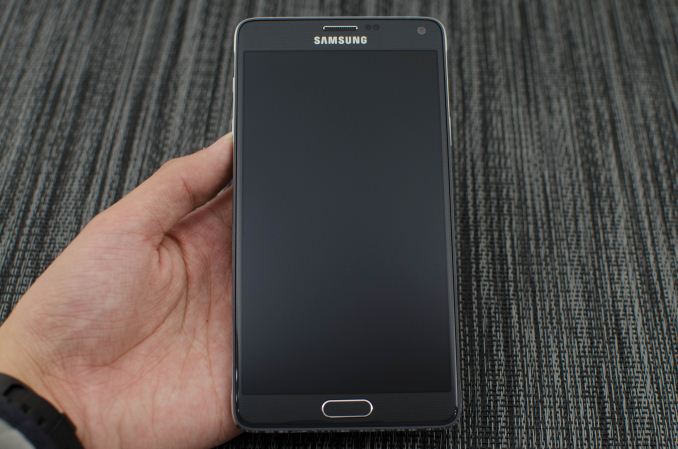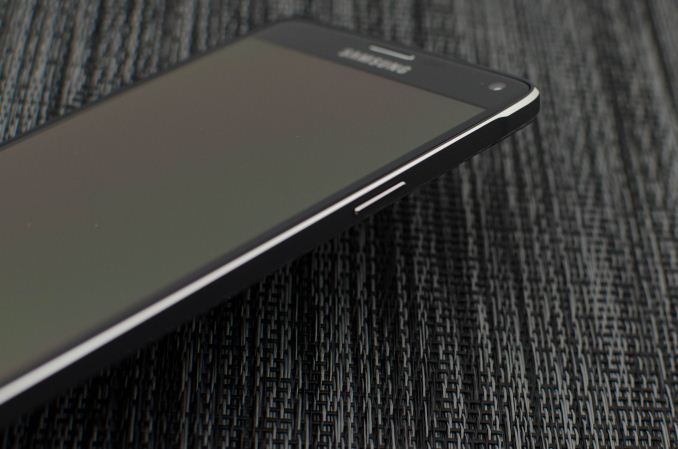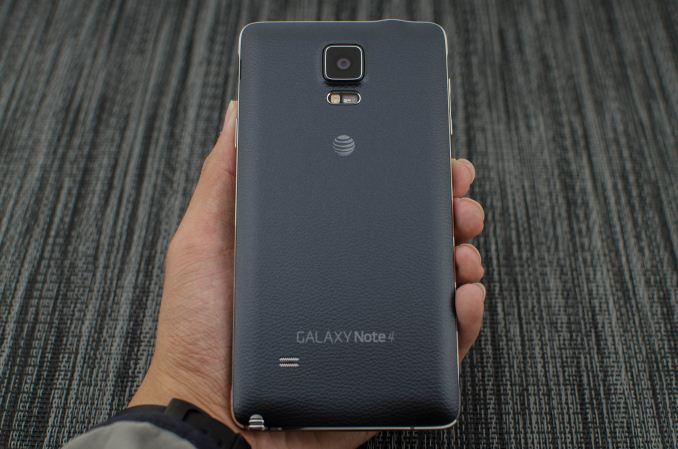The Samsung Galaxy Note 4 Review
by Joshua Ho on October 15, 2014 9:00 AM EST- Posted in
- Smartphones
- Samsung
- Android
- Mobile
- Galaxy Note 4

At this point, the Galaxy Note line needs little introduction. After all, the Galaxy Note is Samsung’s biggest success in mobile. While Apple redefined the smartphone and tablet segment, Samsung defined the phablet segment. Despite widespread skepticism, the original Galaxy Note was a massive success. Combined with the Galaxy S2, 2011 was a watershed year for Samsung as they leapfrogged other Android OEMs. Since then, we’ve seen continuous improvement from year to year with each Galaxy Note. While there were competitors, Samsung managed to hold on to their first-mover advantage for multiple generations. However, with the release of Apple’s iPhone 6 Plus we see one of the first significant threats to Samsung’s dominance of this segment.
The Galaxy Note 4 is Samsung’s latest iteration of the Galaxy Note phablet, and on the surface Samsung has put their best foot forward. With the highest bin of Qualcomm’s Snapdragon 805 or Exynos 5433, the latest generation AMOLED display, a 16MP camera with OIS, and a new design, the Galaxy Note 4 encompasses some of the best hardware that Samsung can deliver. I won’t spend too much time here, but the spec sheet below should cover most of the key points.
| Samsung Galaxy Note 3 | Samsung Galaxy Note 4 | |
| SoC | 2.26 GHz Snapdragon 800 | 2.7 GHz Snapdragon 805 |
| RAM/NAND | 3 GB LPDDR3, 32/64GB NAND + microSD | 3GB LPDDR3, 32GB NAND + microSD |
| Display | 5.7” 1080p Super AMOLED | 5.7” 1440p Super AMOLED |
| Network | 2G / 3G / 4G LTE (Qualcomm MDM9x25 IP block UE Category 4 LTE) | 2G / 3G / 4G LTE (Qualcomm MDM9x35 UE Category 6 LTE) |
| Dimensions | 151.2 x 79.2 x 8.3mm, 168 grams | 153.5 x 78.6 x 8.5 mm, 176 grams |
| Camera | 13MP Rear Facing, 1/3.06" CMOS size (Sony IMX135), 2.1MP FFC | 16MP Rear Facing w/ OIS, 1/2.6" CMOS size (Sony IMX240), F/2.0, 3.7MP FFC w/ F/1.9 aperture |
| Battery | 3200 mAh, 3.8V, 12.1 Whr | 3220 mAh, 3.85V, 12.397 Whr |
| OS | Android 4.4.2 with TouchWiz UX | Android 4.4.4 with TouchWiz UX |
| Connectivity | 802.11a/b/g/n/ac + BT 4.0, USB3.0, GPS/GNSS, MHL, DLNA, NFC | 802.11a/b/g/n/ac + BT 4.1, USB2.0, GPS/GNSS, MHL, DLNA, NFC |
| SIM Size | MicroSIM | MicroSIM |
While all of these things are easily discovered, the most immediate impressions always come from the design of the phone. In this respect, Samsung has done a surprisingly good job. On the front of the phone, we see a relatively standard design for Samsung. This entails a pattern on underneath the glass, which appears to be a bit shimmery in nature, along with dark black pinstripes. This causes a noticeable pattern in the capacitive buttons when lit, as with the LED notification light. There’s the standard earpiece and Samsung logo on top of the display, and a home button on the bottom, which serves as a fingerprint scanner as well. This home button is noticeably clicky in nature, and feels much better than the Galaxy Note 3’s home button.
On the sides, we see a similar level of improvement. The volume rocker, which is on the left side, and power button, which is on the right side, feel fantastic in comparison to most phones, and is quite close to the iPhone 6 and 6 Plus in feel. Unlike most Galaxy smartphones, we see an aluminum frame that runs all along the side of the phone, which also has a chamfered edge to eliminate sharp edges. In this area, Samsung has made serious strides as the frame really helps to make for a better in-hand feel that far exceeds what we saw with the Galaxy Note 3 or even the Galaxy S5. Along the top of the frame are cutouts for the 3.5mm headphone jack and IR port which enables TV remote functionality. Along the bottom of the frame, we see the microUSB 2.0 port. While this is technically a regression from the microUSB 3.0 port in speed and power delivery, I suspect compatibility issues and the ungainly design of the microUSB 3.0 standard justified a move back, at least until USB Type-C is ready for shipping devices.
On the back of the phone, we see some more changes. Instead of the downward-firing speakers of the Galaxy Note 3, we see that the speaker has been moved to the back of the phone. The design of the back cover is more an evolution of the Note 3’s back cover than the Galaxy S5’s, which has a noticeable faux leather pattern although the feel is closer to soft touch plastic. There’s also no stitching to try and make it seem more like leather. Instead, at the edges it seems to meet with the metal frame. A similar level of fit and finish is seen around the LED flash module, which is now flush with the back cover instead of sunk into the phone as with the Galaxy S5.
Overall, the design of the Galaxy Note 4 is massively improved. While it isn’t quite as amazing as the rounded design of the iPhone 6 and 6 Plus, it’s one of the best designs I’ve seen for a phone with a removable back cover. The only complaint I have is that Samsung should use a flat black pattern under the glass to accentuate the high contrast of the AMOLED display, but this is quite minor in nature.












195 Comments
View All Comments
darkich - Wednesday, October 15, 2014 - link
Yep, different approach to low power design.Apple use just two underclocked but very beefed up, large cores, while Qualcomm uses more small, simple, but high clocked cores.
Just think about the fact that Snapdragon 805 probably doesn't draw more power than the A8, even while being clocked twice higher and built on a larger node.
If you doubt that, the Galaxy Note 4 itself is your proof - longer battery endurance than iPhone 6+(according to every other review) despite of having a modestly larger battery, supposedly less efficient OS, triple the RAM, bigger screen and larger resolution panel.
There's probably no way it could achieve that if snapdragon 805 was any less efficient than A8
darkich - Wednesday, October 15, 2014 - link
One more thing.. the CPU benchmarks posted here are nothing but a single threaded Web scripts. Which means, almost entirely dependant on software optimization and single core performance.If you want a good raw performance indication of the CPU setup itself, look up Geekbench.
There the Snapdragon 805 easily beats the A8 in overall score.
The A8 beats it even more easily in the single core part though.
KPOM - Wednesday, October 15, 2014 - link
Not many apps are designed for multicore support. Also, Apple chips run at top speed for longer. It's like comparing Carl Lewis to Paula Radcliffe. Lewis can run faster for short bursts but Radcliffe has more endurance and is still running at the top of her game after 26.2 miles.KPOM - Wednesday, October 15, 2014 - link
Not necessarily. The biggest drain on the battery is the screen. OLED is more efficient than LCD. So perhaps the Qualcomm CPU is less efficient but Samsung makes it up in the display. Now that Samsung seems to have solved the saturation issue perhaps the real story is that if Apple and Samsung were still partners instead of frenemies the battery life on the latest iPhones would be absolutely amazing instead of just good considering the smaller batteries they use.tralalalalalala40 - Saturday, October 18, 2014 - link
not more efficient when browsing the web (white background)tralalalalalala40 - Saturday, October 18, 2014 - link
Because you were lied to by a 100 billion dollar marketing machine. more megapixels is not better (if you don't account for pixel size etc.). more RAM is not better (if you don't account for fast memory compression techniques). more clock speed is not better (if you don't account for electromigration and current leakage, etc. in the transistors).techcrazy - Wednesday, October 15, 2014 - link
Samsung amoled display doesn't appear as sharp as other LCD display. It's because of their PenTile subpixel layout. Their PentTile subpixel layout is lower than a conventional RGB stripe, so true subpixel density increases around 20%. - So basically Samsung's QHD display only 20% sharper than FHD display which has RGB stripe where as LG's QHD display is nearly 80% sharper than FHD display which has RGB stripe. LG's QHD display is the true QHD display and Samsung's QHD is the fake QHD display.grayson_carr - Wednesday, October 15, 2014 - link
Doesn't change the fact that the G3 display isn't very well calibrated, has very poor contrast, and has a terrible oversharpening algorithm that makes things look weird.MattL - Wednesday, October 15, 2014 - link
Good review... two things though:1) Your screen analysis results differ from display mate in an oddly large way, different review unit calibrations maybe? They found it to rate much better on accuracy results than here.
2) Battery life results differ a bit than most other sites, they find the note 4 does better than the iPhone 6. In fairness the web browsing results is where it rates the lowest which is where the iPhone 6 barely beats it here, so that doesn't different too much.
Why don't you do a video battery life test? Or a mixed content test. These are areas that OLED screens should do much better due to white screen vs black energy efficiency, something display mate analyzed in much more detail.
Arcetnathon7 - Wednesday, October 15, 2014 - link
Don't you think strange that diplaymate submit the test weeks before the launch ?Same thing with Galaxy Alpha and GSMarena review.
I really suspect Samsung chosing prototypes. Every other review after launch never meet those results.